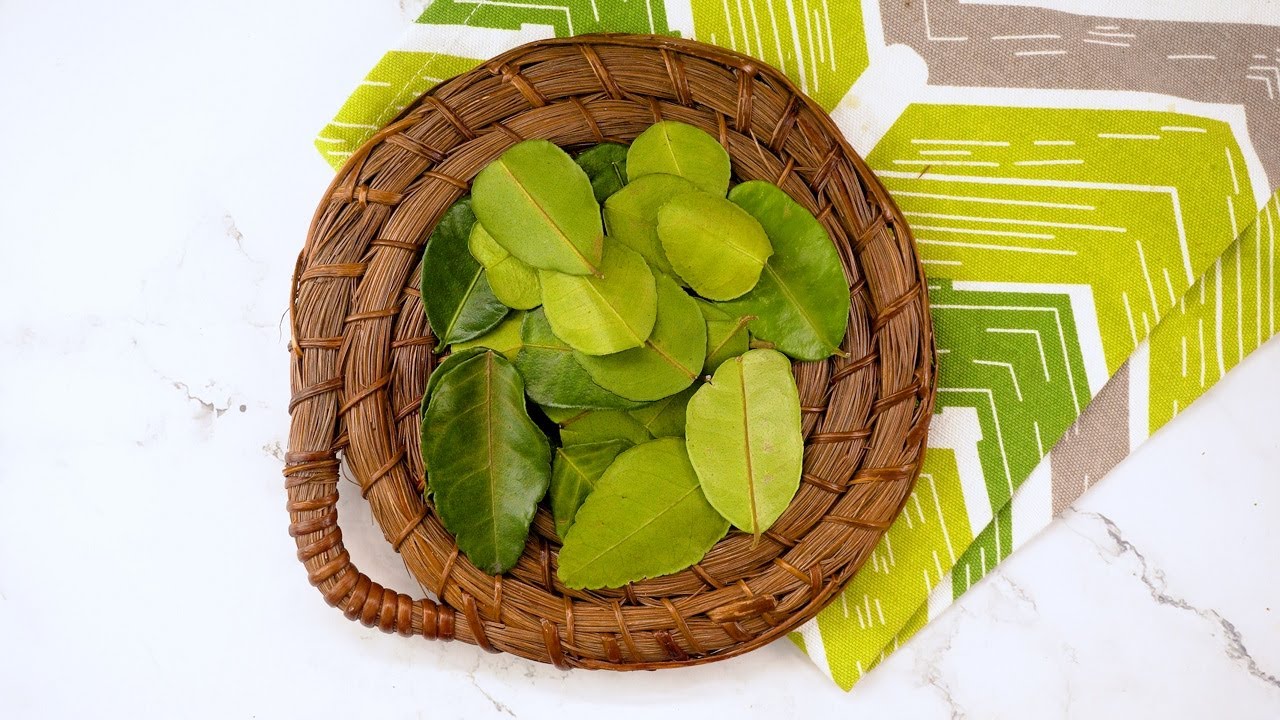How to Use Kaffir Lime Leaf: Tips for Perfectly Spiced and Flavorful Dishes – The aroma of kaffir lime leaves, with their citrusy, herbal, and slightly pungent notes, can transport you to bustling Southeast Asian markets. These fragrant leaves, a staple in Thai, Vietnamese, and other Asian cuisines, offer a unique depth of flavor that elevates dishes from ordinary to extraordinary.
Whether you’re a seasoned chef or a home cook venturing into new culinary territories, understanding how to use kaffir lime leaves effectively is key to unlocking their full potential. This guide will equip you with the knowledge and techniques to incorporate this versatile ingredient into your dishes, transforming them into flavor-packed culinary masterpieces.
Understanding Kaffir Lime Leaves
Kaffir lime leaves, also known as makrut lime leaves, are a unique and versatile ingredient that adds a distinctive flavor to various cuisines. They are an essential component of many Southeast Asian dishes, particularly those from Thailand and Vietnam. These leaves offer a complex flavor profile that is both refreshing and aromatic, making them a popular choice for chefs and home cooks alike.
The Flavor Profile of Kaffir Lime Leaves
The flavor of kaffir lime leaves is a fascinating combination of citrusy, herbal, and slightly pungent notes. The leaves have a distinct aroma that is reminiscent of lime zest, but with a more pronounced herbal quality. They also possess a subtle bitterness that adds depth and complexity to dishes.
This unique flavor profile makes kaffir lime leaves a versatile ingredient that can be used to enhance both sweet and savory dishes.
The Versatility of Kaffir Lime Leaves in Cuisines
Kaffir lime leaves are widely used in Southeast Asian cuisine, particularly in Thai and Vietnamese dishes. They are a key ingredient in many curries, soups, and stir-fries. The leaves are also used to infuse oils, which can then be used to flavor other dishes.
- In Thai cuisine, kaffir lime leaves are commonly used in dishes like Tom Yum soup, Green Curry, and Massaman Curry. They add a bright and aromatic touch to these flavorful dishes.
- In Vietnamese cuisine, kaffir lime leaves are often used in dishes like Pho, a popular noodle soup, and Bun Cha, a grilled pork and vermicelli noodle dish. They provide a refreshing citrusy note that complements the other flavors in these dishes.
Using Kaffir Lime Leaves in Cooking
Kaffir lime leaves can be used in a variety of ways in cooking. The most common method is to use them fresh. The leaves can be added whole to dishes or torn into smaller pieces to release their flavor. Dried kaffir lime leaves are also available and can be used in place of fresh leaves.
They have a more concentrated flavor, so they should be used sparingly.
- Fresh Kaffir Lime Leaves:These are the most common and versatile form of kaffir lime leaves. They can be added whole to dishes or torn into smaller pieces to release their flavor.
- Dried Kaffir Lime Leaves:These leaves have a more concentrated flavor than fresh leaves and are often used in dishes that require a longer cooking time. They can be rehydrated in hot water before using.
- Infused Oils:Kaffir lime leaves can be infused in oil to create a flavorful oil that can be used to flavor other dishes. To infuse oil, simply heat the oil over low heat and add the kaffir lime leaves. Allow the leaves to infuse for several minutes before straining the oil.
Preparing Kaffir Lime Leaves for Cooking: How To Use Kaffir Lime Leaf: Tips For Perfectly Spiced And Flavorful Dishes
Before using kaffir lime leaves in your dishes, proper preparation is essential to unlock their full flavor potential and ensure a pleasant culinary experience. This involves cleaning the leaves thoroughly to remove any dirt or debris and then preparing them according to the specific recipe requirements.
Kaffir lime leaves, with their unique aroma and flavor, can elevate any dish from simple to spectacular. Their versatility extends beyond Southeast Asian cuisine, adding a touch of citrusy zing to everything from curries to soups. While mastering the art of using kaffir lime leaves might seem daunting, the process is surprisingly simple, much like propagating ivy, as explained in the informative article, Ivy Everywhere! The Secret to Fast & Easy Propagation.
Once you’ve mastered the art of incorporating kaffir lime leaves into your cooking, you’ll find yourself reaching for them again and again, adding a touch of exotic flair to your culinary creations.
Cleaning Kaffir Lime Leaves
Cleaning kaffir lime leaves is crucial to remove any dirt, insects, or residues that may be present. This process ensures a clean and flavorful ingredient for your dishes.
- Rinse Under Cold Water:Begin by rinsing the leaves under cold running water to remove any loose dirt or debris. Gently rub the leaves with your fingers to loosen any clinging particles.
- Soak in Saltwater:To further sanitize the leaves and remove any lingering insects, soak them in a bowl of salted water for about 10-15 minutes. The salt helps to draw out any impurities and create a more hygienic ingredient.
- Pat Dry:After soaking, gently pat the leaves dry with a clean kitchen towel or paper towels. This helps to remove excess moisture and prepares them for the next step.
Chopping or Shredding Kaffir Lime Leaves
Finely chopping or shredding kaffir lime leaves is a common method for incorporating their unique aroma and flavor into sauces, soups, or stir-fries. The size of the pieces can be adjusted depending on the desired texture and cooking method.
- Chopping:To chop kaffir lime leaves, use a sharp knife and carefully slice them into thin strips. For a finer chop, stack several leaves together and slice them into thin ribbons. These chopped leaves can be added directly to sauces or soups, or used as a garnish.
- Shredding:Shredding kaffir lime leaves is another effective method for releasing their flavor. Use a sharp knife or a vegetable peeler to gently shred the leaves into thin strips. These shredded leaves can be added to stir-fries, curries, or marinades for a more pronounced flavor.
Creating Kaffir Lime Leaf Paste
A flavorful kaffir lime leaf paste can be made by blending the leaves with other ingredients. This paste is often used in curries or marinades, adding a depth of flavor and aroma to the dish.
- Ingredients:The basic ingredients for a kaffir lime leaf paste include cleaned kaffir lime leaves, garlic, ginger, and sometimes chilies or other spices. The proportions can be adjusted based on personal preference and the desired flavor profile.
- Blending:Combine the ingredients in a blender or food processor and blend until a smooth paste is formed. The consistency should be thick and spreadable.
- Storage:Store the kaffir lime leaf paste in an airtight container in the refrigerator for up to a week. It can be used in curries, marinades, or as a flavorful addition to stir-fries.
Incorporating Kaffir Lime Leaves into Dishes
Kaffir lime leaves are a versatile ingredient that can elevate the flavor of many dishes. They offer a unique citrusy aroma and a subtle, slightly bitter flavor that complements a wide range of cuisines.
Examples of Popular Dishes Featuring Kaffir Lime Leaves
Kaffir lime leaves are commonly used in Southeast Asian cuisines, particularly in Thai, Vietnamese, and Indonesian cooking. Here are some popular examples:
- Tom Yum Soup:This classic Thai soup features kaffir lime leaves, along with lemongrass, galangal, and chili peppers, creating a fragrant and spicy broth. The leaves add a refreshing citrusy note to the soup.
- Green Curry:Kaffir lime leaves are a key ingredient in Thai green curry, where they contribute a unique aroma and a slightly bitter flavor that balances the sweetness of coconut milk and the heat of chilies.
- Thai Basil Fried Rice:This popular street food dish often incorporates kaffir lime leaves, which add a citrusy twist to the savory flavors of the rice, vegetables, and basil.
- Vietnamese Pho:In some variations of Vietnamese pho, kaffir lime leaves are added to the broth, imparting a subtle citrusy flavor and aroma.
Methods of Preparation and Cooking Times
The preparation and cooking times for kaffir lime leaves vary depending on the dish.
Dish |
Preparation Method |
Cooking Time |
|---|---|---|
Tom Yum Soup |
Bruised or torn leaves added to the broth |
Simmered for 10-15 minutes |
Green Curry |
Whole leaves added to the curry paste or simmered in the broth |
Simmered for 15-20 minutes |
Thai Basil Fried Rice |
Finely chopped leaves added towards the end of cooking |
Cooked for 1-2 minutes |
Vietnamese Pho |
Whole leaves added to the broth |
Simmered for 30-45 minutes |
Impact on Aroma, Flavor, and Culinary Experience
Kaffir lime leaves have a profound impact on the aroma, flavor, and overall culinary experience of dishes.
- Aroma:Kaffir lime leaves possess a distinctive citrusy aroma that is both refreshing and invigorating. This aroma can permeate the entire dish, creating a multi-sensory experience.
- Flavor:The flavor of kaffir lime leaves is subtle, slightly bitter, and citrusy. It adds complexity and depth to dishes without overpowering other flavors.
- Culinary Experience:Kaffir lime leaves elevate the culinary experience by adding a unique dimension of flavor and aroma. They can transform a simple dish into something more complex and nuanced.
Tips for Perfecting Kaffir Lime Leaf Flavor
Kaffir lime leaves possess a unique, aromatic flavor profile that can elevate dishes to new heights. However, mastering the art of using them effectively requires understanding how to balance their intensity with other ingredients and techniques. This section delves into the art of maximizing the flavor of kaffir lime leaves in your culinary creations.
Balancing the Intensity of Kaffir Lime Leaves
The intensity of kaffir lime leaves can vary depending on factors such as freshness and variety. It’s crucial to balance their strong citrusy and slightly pungent aroma with the other flavors in your dish. Overusing kaffir lime leaves can overpower the dish, creating an unpleasant bitterness.
- Start with a Small Amount:When incorporating kaffir lime leaves into a recipe, begin with a small quantity and taste as you go. You can always add more if needed.
- Pair with Complementary Flavors:Kaffir lime leaves pair well with other aromatic ingredients like ginger, garlic, lemongrass, and chili peppers. These combinations enhance the complexity of the dish and prevent the kaffir lime leaves from dominating the flavor profile.
- Consider the Dish’s Overall Flavor Profile:The intensity of kaffir lime leaves should be balanced with the overall flavor profile of the dish. For milder dishes, use a smaller amount of kaffir lime leaves. For bolder dishes, you can use a larger amount.
Adjusting the Amount of Kaffir Lime Leaves
The amount of kaffir lime leaves you use will depend on the desired level of flavor and the specific dish you are preparing.
- For a Subtle Hint of Flavor:Use 1-2 leaves for a mild, aromatic touch. This is suitable for dishes like soups, stews, and curries where the kaffir lime leaf is meant to add a subtle background flavor.
- For a More Pronounced Flavor:Use 3-4 leaves for a more noticeable, citrusy aroma. This works well for dishes like stir-fries, marinades, and sauces where the kaffir lime leaf plays a more prominent role.
- For a Strong, Intense Flavor:Use 5-6 leaves for a powerful, citrusy punch. This is appropriate for dishes like curries, where the kaffir lime leaf is meant to be a dominant flavor.
Extracting Maximum Flavor from Kaffir Lime Leaves
Various cooking techniques can enhance the flavor of kaffir lime leaves.
- Bruising or Tearing:Bruising or tearing the leaves releases their essential oils, intensifying their flavor. This is a common practice in Thai cooking, where the leaves are often bruised before being added to curries.
- Infusion:Infusing kaffir lime leaves in hot oil or broth allows their flavors to infuse the liquid. This is an effective method for adding a subtle, aromatic touch to dishes like soups and stews.
- Boiling:Boiling kaffir lime leaves in a liquid releases their flavor more intensely. This technique is often used in curries and soups, where the leaves are boiled for a longer period to infuse their flavor into the dish.
Creative Applications of Kaffir Lime Leaves

Kaffir lime leaves, with their unique aroma and flavor, offer a world of culinary possibilities beyond traditional Thai and Southeast Asian cuisine. Let’s explore some creative and unconventional ways to incorporate these fragrant leaves into your dishes, beverages, and even desserts.
Infused Oils and Vinegars
Infusing oils and vinegars with kaffir lime leaves adds a vibrant, citrusy dimension to your culinary creations. The leaves impart a subtle, yet complex flavor that elevates the taste of both savory and sweet dishes.
For oil infusions, gently heat a neutral oil like grapeseed or avocado oil with finely chopped kaffir lime leaves. Allow the leaves to infuse for several hours or overnight, then strain the oil before use. You can use this infused oil for marinades, dressings, or even drizzling over cooked vegetables or grilled meats.
For vinegars, infuse white wine vinegar or apple cider vinegar with kaffir lime leaves for a refreshing and tangy condiment. The infused vinegar can be used for salad dressings, marinades, or even as a finishing touch for soups and stews.
Adding a touch of kaffir lime leaf to your dishes can elevate the flavor profile to new heights. The fragrant leaves, with their citrusy and slightly peppery notes, are a versatile ingredient for both savory and sweet recipes. If you’re looking to cultivate your own herb garden, consider starting with ivy, which is easy to propagate from cuttings.
Learn more about how to grow ivy plants from scratch in this helpful guide: How to Grow Ivy Plants from Scratch: Propagation Made Simple. Once you’ve mastered the art of propagation, you can use fresh kaffir lime leaves to create a variety of delicious and aromatic dishes.
Kaffir Lime Leaves in Cocktails and Beverages
Kaffir lime leaves add a refreshing and aromatic twist to cocktails and other beverages. Their subtle citrusy flavor complements a wide range of spirits and mixers, creating unique and flavorful concoctions.
For cocktails, muddle a few kaffir lime leaves with your preferred spirit, such as vodka, gin, or rum. Add your favorite mixers, such as tonic water, soda, or fruit juice, and garnish with a fresh kaffir lime leaf for a beautiful and fragrant presentation.
For non-alcoholic beverages, infuse water or tea with kaffir lime leaves for a refreshing and invigorating drink. Add a few leaves to a pitcher of water or steep them in hot water for a few minutes to create a fragrant and flavorful tea.
Kaffir Lime Leaves in Desserts, How to Use Kaffir Lime Leaf: Tips for Perfectly Spiced and Flavorful Dishes
The subtle citrusy notes of kaffir lime leaves can add a unique and refreshing twist to desserts. Their delicate flavor complements a wide range of sweet treats, from cakes and cookies to ice cream and sorbets.
For cakes and cookies, incorporate finely chopped kaffir lime leaves into the batter for a subtle citrusy flavor. You can also use the infused oil or vinegar mentioned earlier to add a deeper citrusy dimension.
For ice cream and sorbets, infuse a simple syrup with kaffir lime leaves and use it to flavor your frozen treats. The subtle citrusy flavor complements the sweetness of the dessert and adds a refreshing touch.
Closure

With a little practice and a dash of creativity, you’ll be able to harness the power of kaffir lime leaves to create dishes that tantalize the senses and leave a lasting impression. From subtle hints of citrus in a delicate soup to bold bursts of flavor in a fiery curry, kaffir lime leaves offer a world of culinary possibilities.
So, embrace the unique character of this aromatic ingredient and embark on a flavorful journey to elevate your cooking to new heights.
FAQ Resource
Can I substitute kaffir lime leaves with lime zest?
While lime zest can offer a similar citrusy flavor, it won’t capture the full complexity of kaffir lime leaves. The leaves provide a unique combination of citrus, herbal, and slightly pungent notes that lime zest alone cannot replicate.
Where can I find kaffir lime leaves?
Kaffir lime leaves are readily available at Asian grocery stores, specialty markets, and some larger supermarkets. They are also often sold online.
How long can I store kaffir lime leaves?
Fresh kaffir lime leaves can be stored in the refrigerator for up to a week. For longer storage, you can freeze them for up to 3 months.
